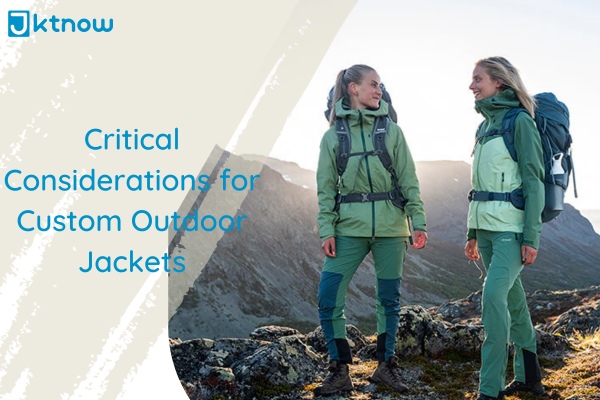Crafting custom outdoor jackets that go beyond the ordinary requires a thoughtful fusion of design, practicality, and personal style. This blog delves into the essential factors to consider when customizing outdoor jackets.
From purpose-driven design choices to weather-resistant features, we ensure your custom jackets embrace your unique identity and stand ready to tackle the elements.
Purpose and Intended Use of Outdoor Jackets
The purpose and intended use of outdoor jackets are pivotal in guiding their design, features, and material selection. Outerwear is not one-size-fits-all garments but specialized clothing tailored to specific activities and environments. Whether hiking through rugged terrains, shredding down ski slopes, or staying warm during everyday commutes, the jacket’s intended use shapes every aspect of its creation.

Different outdoor activities demand distinct features and functionalities. For example, a hiking jacket may require multiple pockets for storage and adjustable cuffs to prevent debris from entering. On the other hand, a ski jacket might need ventilation zippers to regulate body temperature during intense physical activity.
Defining outdoor jackets’ purpose and intended use is not just about creating specialized clothing—it’s about enhancing performance, comfort, and safety. Whether navigating challenging landscapes, hitting the slopes, or enjoying strolls, a jacket customized to its purpose ensures that you’re well-equipped.
Material Selection for Custom Outdoor Jackets
Selecting suitable materials for custom outdoor jackets is crucial to ensure optimal performance, durability, and comfort, like the windbreaker, soft shells, and more.
Outer Shell Fabric
Waterproof and Breathable: Look for fabrics with waterproof and breathable membranes like Gore-Tex or eVent. These materials keep water out while allowing moisture vapor to escape, keeping you dry inside and out.
Windbreak: Choose fabrics that offer wind resistance to prevent cold air from penetrating the jacket.
Durable: Opt for abrasion-resistant materials to withstand rough outdoor conditions.
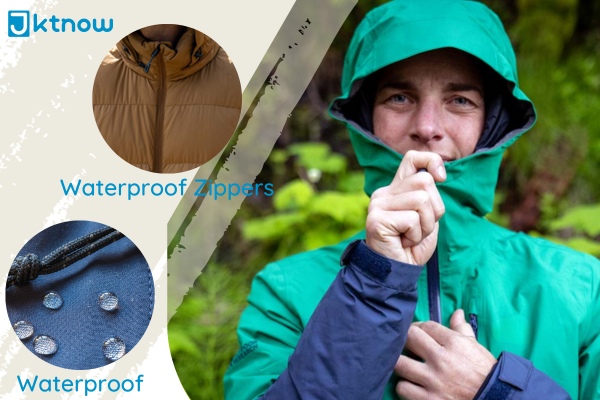
Insulation
Down: Provides excellent warmth-to-weight ratio and compressibility, suitable for cold conditions. Ensure the down is responsibly sourced.
Synthetic: Synthetic insulation retains warmth even when wet and dries quickly. Ideal for wet environments or high-intensity activities.
Lining
Moisture-Wicking: The lining should wick sweat away from the body to keep you dry and comfortable.
Breathable: The lining should allow moisture vapor to escape to prevent condensation inside the jacket.
Zippers
Waterproof Zippers: These prevent water from seeping through zippers, maintaining the jacket’s integrity.
Ventilation Zippers: Jackets with pit zips or underarm vents enhance breathability during intense activities.
Seams
Taped Seams: Seams should be fully taped to prevent water from entering through stitching.
Closures and Fasteners
Velcro Cuffs: Adjustable cuffs allow you to seal the wrists to keep out cold air and snow.
Drawcord Hem: A drawcord hem helps cinch the jacket at the waist, preventing drafts.
Pockets
Waterproof Pockets: Essential for keeping items dry in wet conditions.
Mesh Pockets: Provide additional ventilation and storage without adding weight.
Weight and Packability
Consider the jacket’s weight and packability depending on the intended use. Lightweight jackets are suitable for activities where mobility is crucial.
Design Custom Elements
Indeed, when customizing outdoor jackets, several design elements can make your jackets unique and visually appealing, like custom embroidered jackets, personalized jackets, and more. When adding personalized text to your custom outdoor jacket, check out our blog on adding text to outdoor jackets.
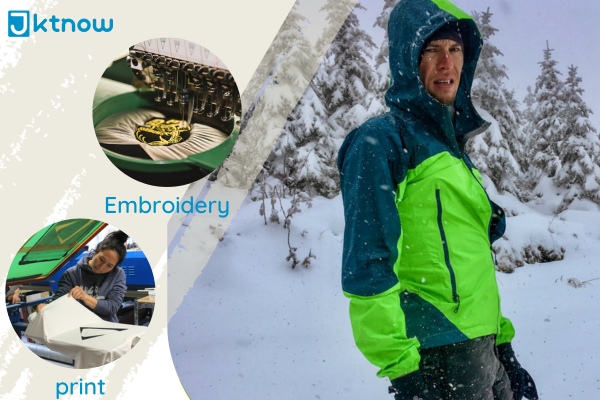
Patterns and Prints
Incorporate patterns, prints, or textures that resonate with the jacket’s purpose. Camouflage, geometric patterns, or nature-inspired designs can enhance the visual appeal.
Logo Placement
Decide where to place your brand’s logo or any other custom graphics. Common locations include the chest, sleeve, or back. The size and prominence of the logo can influence the overall design.
Embroidery and Appliqué
Add dimension and detail through embroidery or appliqué. This technique allows intricate designs, text, or branding elements to be incorporated directly into the fabric.
Piping and Trims
Consider using piping, trims, or binding in complementary colors to outline seams, pockets, or edges. It can provide a refined and tailored appearance.
Reflective Elements
Incorporate reflective materials or piping for improved visibility in low-light conditions. It is essential for safety in outdoor activities.
Hood and Collar Design
Experiment with different hood and collar styles to match the jacket’s purpose. For example, a detachable hood might be suitable for versatile outdoor jackets.
Ventilation and Breathability
Consider incorporating breathable mesh panels or underarm vents for improved comfort during strenuous activities.
Pocket Styles
Explore various pocket designs like zippered, flap, or mesh pockets. Each style serves different purposes and contributes to the overall design.
Closures and Fasteners
Decide on closure types, such as snaps, buttons, or Velcro, based on the jacket’s functionality and aesthetic preferences.
Functionality and Features of Custom Outdoor Jackets
Indeed, here are some essential functionalities and features to consider when customizing outdoor jackets:
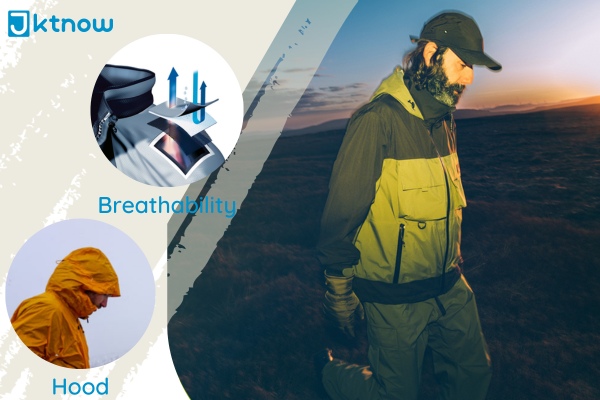
Functionality
Weather Resistance: Outdoor jackets should protect against varying weather conditions. It includes being windproof, waterproof, and breathable to ensure comfort and performance in different environments.
Insulation: Jackets designed for colder climates or winter sports should offer sufficient insulation to keep wearers warm. Different insulation materials and technologies can be chosen based on the temperature range.
Breathability: Proper ventilation and breathability prevent overheating and moisture buildup inside the jacket during physical activities, enhancing comfort and performance.
Mobility and Flexibility: Outdoor activities require a full range of motion. Jackets should be designed with articulated sleeves, ergonomic cuts, and stretch panels to allow easy movement.
Packability: Jackets easily folded or packed into a small space are convenient for travel or outdoor excursions.
Features
Pockets: Different types and sizes of pockets can serve various purposes, such as storing essentials like keys, phones, or gloves. Consider interior pockets, chest pockets, and handwarmer pockets.
Zippers: High-quality zippers are essential for ease of use and durability. Waterproof or water-resistant zippers can prevent moisture from seeping in.
Hood: A detachable or adjustable hood provides extra protection during rainy or windy conditions. Some hoods are helmet-compatible for activities like skiing or climbing.
Cuffs and Seals: Adjustable cuffs with hook-and-loop closures or elastic seals help seal out cold air and moisture. Some jackets also have thumbholes for added hand coverage.
Quality Control of customizing
Quality control is a crucial aspect of the manufacturing process for custom outdoor jackets. It ensures that each jacket meets the desired functionality, durability, and quality standards.
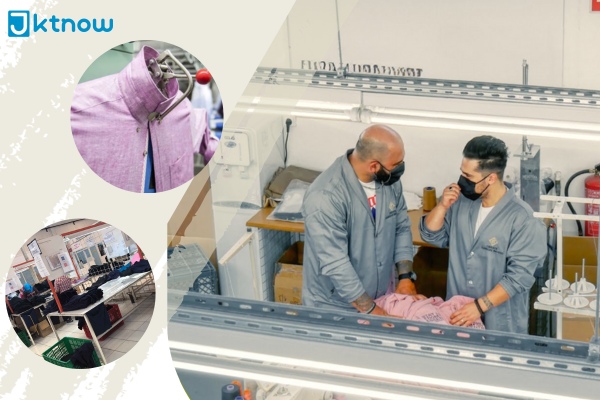
Material Inspection
Thoroughly check all incoming materials for defects or inconsistencies, including fabrics, zippers, buttons, insulation, and trims. Verify that materials meet the specified quality standards and are suitable for the jacket’s intended use.
Pre-Production Sampling
Create a prototype or sample jacket based on the custom design. Assess the sample for accurate sizing, proper construction, and adherence to design specifications.
In-Process Inspection
Conduct regular inspections during manufacturing to identify any deviations from quality standards. Check for consistent stitching, proper alignment of components, and accurate placement of design elements.
Functional Testing
Test all features and functionality, such as zippers, snaps, buttons, and pockets, to ensure they operate smoothly and securely. Verify the effectiveness of weather-resistant features like waterproofing and insulation.
Fit and Sizing Evaluation
Measure and assess the jacket’s fit and sizing against the specified standards. Ensure that the jacket provides the wearer with the intended level of comfort and mobility.
Final Inspection
Conduct a comprehensive final inspection of each jacket before packaging and shipping. Verify that all quality standards have been met and that the jacket meets the customer’s specifications.
Conclusion
In outdoor jackets, customization brings a harmonious blend of style and functionality to life, tailored to individual needs and brand identities. By embracing these fundamental considerations, you pave the way for jackets that embody both the rugged spirit of the outdoors and the finesse of bespoke craftsmanship. You would choose the right outdoor jacket, ideally for yourself.
Get High-Quality Custom Outdoor Jackets From Jktnow!
If you’re ready to turn these critical considerations for custom outdoor jackets into reality, look no further than Jktnow. As a professional outdoor jacket manufacturer and wholesaler based in China, we offer a wide range of outdoor jackets that can be tailored to your unique preferences. We’ve covered whether you need custom designs, logos, specific materials, or affordable pricing.
Our commitment to quality and customization ensures you’ll get the perfect outdoor jacket for your adventures. Don’t wait any longer – take the next step towards your dream custom outdoor jacket by contacting us today. Your outdoor experiences deserve the best, and Jktnow is here to deliver.
FAQs
Q1. How much should I spend on a custom outdoor jacket?
The price of a custom outdoor jacket can vary significantly based on materials and features. However, consider it an investment in your outdoor comfort and safety. A good-quality jacket can range from $200 to $600 or more.
Q2. Can I use a custom outdoor jacket for multiple activities?
Yes, many custom outdoor jackets are versatile enough for various outdoor activities. Just ensure it has the features and materials suitable for your needs.
Q3. What’s the difference between waterproof and water-resistant jackets?
Waterproof jackets are designed to keep you dry even in heavy rain, while water-resistant jackets provide limited protection against light rain or drizzle. Choose according to your expected weather conditions.
Q4. How often should I clean my custom outdoor jacket?
Cleaning frequency depends on usage. If you wear it frequently, aim for at least once a season. However, always follow the manufacturer’s care instructions.
Q5. Can I add extra insulation to my custom outdoor jacket if it’s not warm enough?
While some jackets offer the option to add extra insulation, it’s generally not recommended to modify your jacket. Instead, consider layering with appropriate base layers and mid-layers for added warmth.

